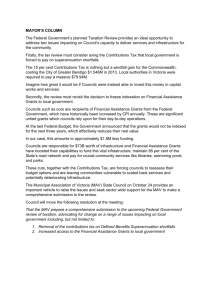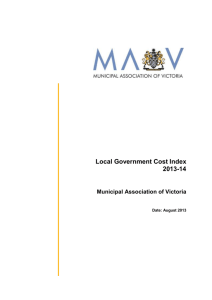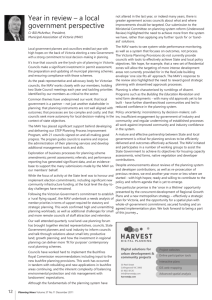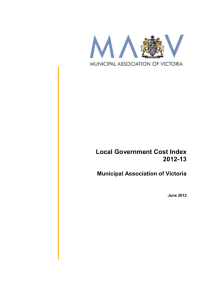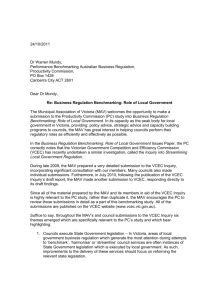2008 cost index report - Municipal Association of Victoria
advertisement
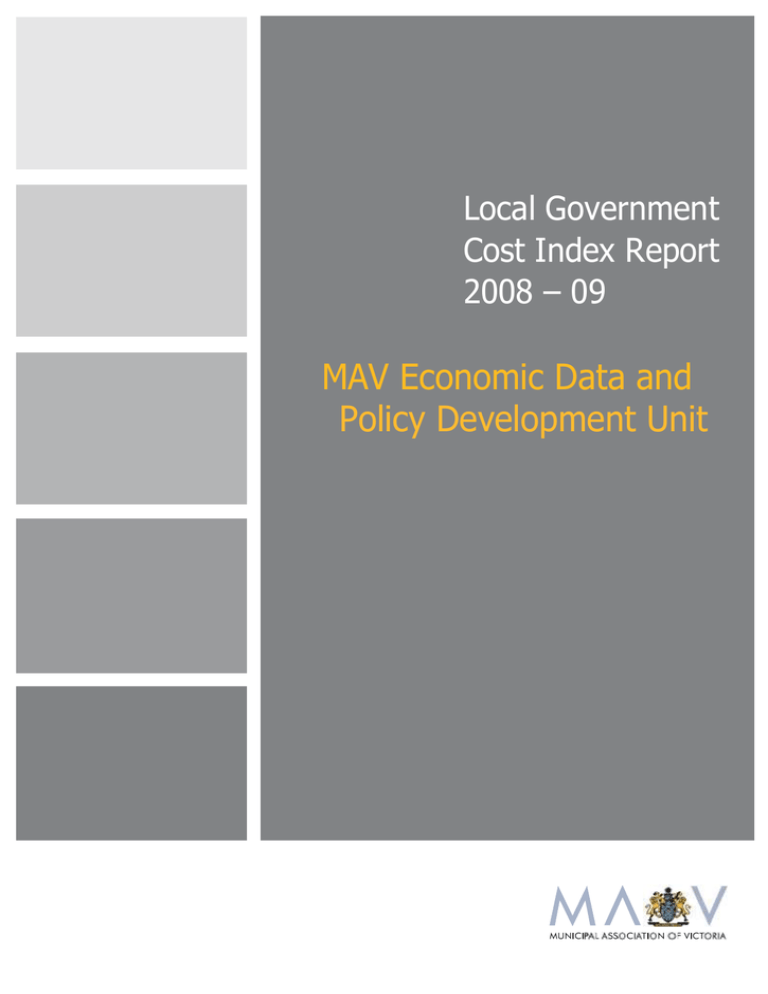
Local Government Cost Index Report 2008 – 09 MAV Economic Data and Policy Development Unit © Copyright Municipal Association of Victoria, 2008. The Municipal Association of Victoria is the owner of the copyright in the publication Local Government Cost Index 2008-09. No part of this publication may be reproduced, stored or transmitted in any form or by any means without the prior permission in writing from the Municipal Association of Victoria. All requests to reproduce, store or transmit material contained in the publication should be addressed to the Manager of Economic Data and Policy Development on 9667 5555. May 2008 The MAV can provide this publication in an alternative format upon request, including large print, Braille and audio. MAV Local Government Cost Index 2008-09 1 Local Government Cost Index 2008-09 Introduction In assessing the movement in expenses for an industry over time, an important variable is the development of a cost index to identify the underlying movement in the industry’s input costs (effectively the cost of its basket of goods). Perhaps the best known index is the Consumer Price Index (CPI), which measures the price movements of a standard basket of services reflecting household consumptions, including food; alcohol; tobacco; clothing and footwear; housing; and house contents, among other factors. While the CPI broadly reflects movements in household consumer spending, it is not necessarily applicable to industries with a significantly different composition, such as local government. In such cases, an alternative cost index should be adopted to better reflect the movement in costs of that particular industry or sector. This paper details the rationale for why movement in local government costs should be based on the weighted average of wage and building expense movements which, when combined, form a Local Government Cost Index for Victoria. Local Government Cost Index Forecast Analysis undertaken by the MAV has estimated that a Victorian Local Government Cost (LGC) Index for 2008-09 is forecast to move by an average 4.4 per cent per annum. The Local Government Cost index is based on a combination of the Wage Cost Index and the Macromonitor’s forecast movement in non-residential construction costs. Background Previous work undertaken by the Municipal Association of Victoria (MAV) looked at the escalation in local government costs and what indicators best tracked those movements. The paper considered a range of indicators and argued that Average Weekly Earnings (AWE) and a composite measure of AWE and the Bureau of Transport and Regional Economics’ (BTRE) Road Construction and Maintenance Index were the most appropriate indices for tracking local government costs. The findings for 2006-07 have been added to the data set and continue to show that these indices best reflect cost increases for the sector and the inappropriateness of State and Commonwealth agencies’ use of the Consumer Price Index (CPI) to adjust grants. One thing of note is that growth in the Wage Cost Index (WCI) over the past two years has outstripped AWE. MAV Local Government Cost Index 2008-09 2 The MAV considered incorporating further cost indexes to reflect the movement in other input costs, such as utilities, office equipment, vehicle travel, etc but did not adopt these further indices for the following reasons: 1. it raises an issue about the complexity of the index, particularly as it is based on forward estimates of input costs (rather than historic trends) 2. further information is required about the significance of each cost on local government and the extent of variation which exists between councils. This issue affects the relative weighting that would be applied to each cost index 3. historic data indicates that the movement in non-wage or construction related costs has matched AWE movements, suggesting this is a reasonable proxy for these additional expenditures. The MAV will undertake further analysis of the expenditure profile of local government to assess whether the inclusion of additional cost indices is justified. Forward Estimates The purpose of the analysis is to estimate the reasonable cost movements facing the local government sector in Victoria. The cost pressures facing individual municipalities will vary from the sector-wide approach, depending on the exact basket of goods and services it delivers. For example, a rural council which predominantly delivers infrastructure will face different cost pressures to a metropolitan council with greater human service delivery. Councils should not adopt these forecasts without further analysis to confirm the most appropriate mix of cost indexes for their municipality. Providing guidance for councils with respect to budgeting for cost increases is difficult. Put simply, the MAV’s preferred tracking indices are good historically but there is no “official” basis on which to provide a forecast. Should councils adopt the MAV’s forecast of sector cost increases, the forecasts to some extent become selffulfilling. This is, however, no different to government forward estimates that are built into actual wage demands. Commonwealth and State budgets include forward estimates of wages (WCI) and costs (CPI). The following forward estimates have been provided in the Commonwealth and Victorian State budgets. CPI 200607 CPI 200708 CPI 200809 CPI 200910 WCI 200607 WCI 200708 WCI 200809 WCI 200910 Commonwealth 2.10 4.00 3.50 3.25 4.00 4.25 4.25 4.25 Victorian State 2.70 3.25 3.00 2.75 3.60 3.75 3.75 3.75 MAV Local Government Cost Index 2008-09 3 Historically, AWE has been a better indicator of the sector’s labour cost movements than the WCI. However, there is no forward estimate of AWE. The data for the previous three quarters indicates that the full year movement in AWE for 2007-08 may be 3.3 per cent. Victoria CPI WCI AWE 2000-01 3.8 3.4 4.2 2001-02 2.8 3.5 7.3 2002-03 3.2 3.6 6.7 2003-04 2.3 3.2 5.0 2004-05 2.0 3.9 4.6 2005-06 3.2 3.8 2.9 2006-07 2.6 3.6 3.0 On the issue of construction, the significant fluctuation in the BTRE’s Road Construction and Maintenance Index is noted. In 2005-06 it increased by 6.9 per cent, however in 2006-07 it increased by only 1.8 per cent. Given the impacts arising from increasing petroleum products and energy prices, forecasting accurate building and construction cost movements is complex . Several measures of cost movements are available which indicate differences in measured movement between various measures of construction costs. Looking across all the available indices the following is indicated: the average annual increase over the past seven years in BTRE index is 4.3 per cent; and the ABS indices for Road and Bridge Construction and Non-Building Construction for 2006-07 were both 4.5 per cent - in stark contrast to the BTRE’s figure. The indices have also been relatively consistent over the past seven years. However, the last two quarters of 2007-08 indicate it may be over 5 per cent. There is good reason to believe that the cost of construction will at least be as high as earnings and materially higher than CPI in 2008-09. Some forecasts for energy costs have been as high as 14 per cent per annum for electricity and gas prices will also rise appreciably as it becomes more attractive (energy costs will impact steel, concrete, aluminium production prices). Oil futures have also set record highs which will have a significant impact on road construction costs. It will be important in the future to continue to specifically recognise construction costs in any index, particularly with the future inclusion of externalities (greenhouse gas costs). Macromonitor, a firm providing forward estimates of construction costs has indicated it expects the full year increase for 2007-08 to be 6 per cent and over the four years to 2007-08 to average 6.5 per cent. Its forecasts indicate easing of construction cost increases in 2009-10 and cost increases less than general inflation in 2010-11. On the balance of the available data, both historic and this independent forecast, a figure of 6 per cent for construction costs has been adopted for 2007-08 and 2008-09. MAV Local Government Cost Index 2008-09 4 Application of the Formula Using the MAV methodology, the weighted index of labour (80 per cent) and construction (20 per cent) costs would give: AWE WCI Construction Overall 2007-08 Weighted Weighted 2008-09 Weighted Forecasts 3.30% 4.00% 6.00% Index 2.64% Index Forecasts Index 3.20% 1.20% 4.40% 4.00% 6.00% 3.20% 1.20% 4.40% 1.20% 3.84% WCI is average of Commonwealth & Victorian State forecasts Conclusion The analysis indicates that, on average, the sector’s costs are forecast to increase by 4.40 per cent in 2008-09 due to continued strong growth in construction costs and moderate wage cost increases. The influence of cost growth on individual councils will vary depending on the mix of goods and services provided. This means that for some councils, particularly those with greater than average expenditure on infrastructure, expected costs will increase at a faster rate than forecast by this index. In contrast, for other councils, particularly those with greater than average expenditure on human services and other staff-based services, expected costs will increase at a lower rate than forecast by the index. MAV Local Government Cost Index 2008-09 5
